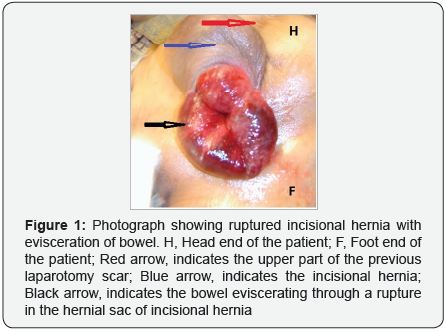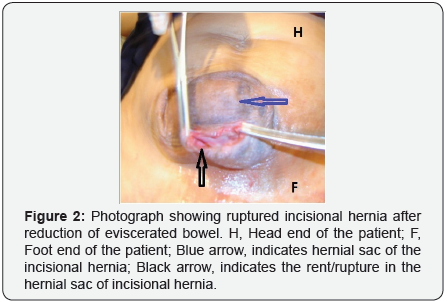Juniper Publishers| Spontaneous Rupture of Incisional Hernia - A Case Report
Journal of Surgery- JuniperPublishers
Abstract
A 40- year old female presented with spontaneous rupture of 8-year old Incisional hernia through midline abdominal scar and evisceration of small bowel. Emergency operation with polypropylene mesh hernioplasty was carried out. Outcome with a brief review of literature is discussed.
Keywords: Spontaneous rupture; Incisional hernia; Ruptured hernia; Ruptured incisional hernia; Emergency mesh repair
Introduction
Incidence of postoperative incisional hernia has been at least 10% on long-term follow-up even in the best centers [1]. The hernia steadily increases in size with attendant heavy sickening/ dragging sensation aggravated by coughing/ straining and recurrent attacks of incomplete obstruction with colicky pain & vomiting; sometimes complicated by complete obstruction and strangulation, and often intertrigo in deep creases between large dependant hernia and abdominal wall. Late dehiscence of incisional hernia is rare [2]. A case of spontaneous rupture of incisional hernia with bowel evisceration is presented here with a brief review of literature.
Case Report
A 40-year old female presented with the complaint of bowel protrusion from a ruptured ventral incisional hernia. The hernia had been present for last 8 years through the lower part of the midline scar, with history of emergency laparotomy for tubercular ileal perforation before 10 years through midline incision, & elective open cholecystectomy before 12 years through subcostal incision. On examination, patient was pale, pulse rate 106/min. and B.P. 206/158 mmHg. Subcostal scar on abdomen was intact while a large incisional hernia was present through the lower part of the midline scar that was thin and papery with rupture at the bottom of the hernia sac through which a loop of pink viable small bowel was eviscerating (Figure 1).

The bowel was reduced by gentle digital manipulation after cleansing with warm saline (Figure 2) and urgent operation was planned. Her haemogram, renal function and blood sugar were within normal limits, and ABG (Acid base and gas) analysis showed mild respiratory alkalosis. Nitroglycerine intravenous infusion @ 4 μg/ Kg/ minute was started to reduce the blood pressure. Emergency operation was performed after normalization of the blood pressure. A loop of small bowel was found adherent to superior aspect of the hernial defect and it was dissected free; hernial sac with redundant skin was excised, and the large hernial defect of about 10 x 8 cms in size was closed by polypropylene mesh underlay repair with placement of omentum between the mesh and bowel loops. Postoperative period was uneventful except for a minor stitch abscess at the lower end of the wound that cleared in 3 days and patient was discharged from the hospital on 8th day. Patient was followed up regularly in the outpatient department. At 2-year follow-up, the scar was healthy and intact with no recurrence of hernia.

Discussion
With time, incisional hernia becomes large & dependant. The overlying skin gets thinned out and avascular with resultant atrophy; areas of ischaemic necrosis appear with constant risk of ulceration & infection. This may rarely progress to dehiscence of the attenuated coverings of the hernia spontaneously or due to increased intra-abdominal pressure [2]. When eviscerated bowel is easily reducible into the abdomen and no gross infection is present, emergency repair is recommended preferably using mesh [3,4], and this policy was adopted in our patient with good results. However, in presence of unfavorable conditions of strangulation, local infection, obesity and cardio-pulmonary problem, the primary hernioplasty is considered hazardous, and the two-stage procedure of emergency simple skin closure after excision of redundant atrophic skin followed by elective hernioplasty later on is preferable [5].
Our experience and review of the literature indicate that late dehiscence may rarely develop in long-standing neglected incisional hernia [6,7], and hence formal hernioplasty is strongly recommended once post-operative incisional hernia is detected. In order to safeguard against this potentially fatal but preventable complication, all patients with incisional hernia should be encouraged and convinced for need of early elective operation, especially in developing countries with limited resources, ignorance and illiteracy, often coupled with lack of timely access to surgical care.
Conclusion
Long standing incisional hernia has a small but definite risk of late spontaneous rupture. In absence of unfavorable conditions, emergency repair using polypropylene mesh is easily accomplished with satisfactory results. Patient education and persuasion for early elective hernioplasty is crucial to safeguard against this potentially fatal but preventable complication.

Comments
Post a Comment